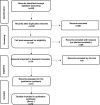The Evolution of Diagnostic Techniques in the Paleopathology of Tuberculosis: A Scoping Review
- PMID: 37900966
- PMCID: PMC10603826
- DOI: 10.20411/pai.v8i1.597
The Evolution of Diagnostic Techniques in the Paleopathology of Tuberculosis: A Scoping Review
Abstract
Tuberculosis (TB) is an ancient chronic infectious disease that remains a global health concern. In human remains, the most common and characteristic clinical signs are the skeletal modifications involving the spine, such as in Pott's disease. Diagnosing TB in ancient human remains is challenging. Therefore, in this systematic review, the authors investigated the studies assessing molecular diagnosis of Pott's disease in ancient human remains with the intention to survey the literature, map the evidence, and identify gaps and future perspectives on TB in paleopathology. Our systematic review offers a full contextualization of the history of Pott's disease in ancient times. Our search strategy was performed between August 2022 and March 2023. The authors initially identified 340 records, and 74 studies were finally included and assessed for qualitative analysis. Due to non-specific clinical signs associated with TB, how best to diagnose tuberculosis in human remains still represents a central point. Nevertheless, ancient DNA (aDNA) analysis, lipid biomarkers, and spoligotyping might be extremely useful tools in the study of TB in human remains. Moreover, we propose the extraction and study of immune response genes involved in innate and adaptive immunity versus Mycobacterium spp. as an innovative and vastly overlooked approach in TB paleopathology. Complementary methodologies should be integrated to provide the best approach to the study of TB in human remains.
Keywords: Mycobacterium Tuberculosis Complex (MTBC); Tuberculosis; ancient DNA; human remains; spondylodiscitis.
Copyright © 2023 Pathogens and Immunity.
Conflict of interest statement
The authors declare no conflict of interest.
Figures


Similar articles
-
Morphologic and Clinical Aspects of Pott Disease in Ancient Human Remains: A Scoping Review.Spine (Phila Pa 1976). 2025 Feb 15;50(4):E56-E69. doi: 10.1097/BRS.0000000000005190. Epub 2024 Oct 15. Spine (Phila Pa 1976). 2025. PMID: 39451151
-
Tuberculosis in Late Neolithic-Early Copper Age human skeletal remains from Hungary.Tuberculosis (Edinb). 2015 Jun;95 Suppl 1:S18-22. doi: 10.1016/j.tube.2015.02.011. Epub 2015 Feb 13. Tuberculosis (Edinb). 2015. PMID: 25857937
-
Mycolic acids and ancient DNA confirm an osteological diagnosis of tuberculosis.Tuberculosis (Edinb). 2001;81(4):259-65. doi: 10.1054/tube.2001.0295. Tuberculosis (Edinb). 2001. PMID: 11584593
-
[Tuberculosis in ancient Egypt].Rev Mal Respir. 2007 Dec;24(10):1277-83. doi: 10.1016/s0761-8425(07)78506-6. Rev Mal Respir. 2007. PMID: 18216748 Review. French.
-
The paleopathological evidence on the origins of human tuberculosis: a review.J Prev Med Hyg. 2020 Apr 30;61(1 Suppl 1):E3-E8. doi: 10.15167/2421-4248/jpmh2020.61.1s1.1379. eCollection 2020 Mar. J Prev Med Hyg. 2020. PMID: 32529097 Free PMC article. Review.
Cited by
-
Historical and Social Considerations upon Tuberculosis.J Prev Med Hyg. 2025 May 31;66(1):E145-E152. doi: 10.15167/2421-4248/jpmh2025.66.1.3465. eCollection 2025 Mar. J Prev Med Hyg. 2025. PMID: 40756185 Free PMC article.
References
-
- Aufderheide AC, Rodriguez-Martin C, Langsjoen O.. The Cambridge Encyclopedia of Human Paleopathology. Cambridge: Cambridge University Press; 1998 1998.
-
- Papa V, Galassi FM, Varotto E.. Representation of Spinal tuberculosis in a ptolemaic dwarf statuette 2020;XXVI(1):188–95.
Publication types
LinkOut - more resources
Full Text Sources
Miscellaneous
